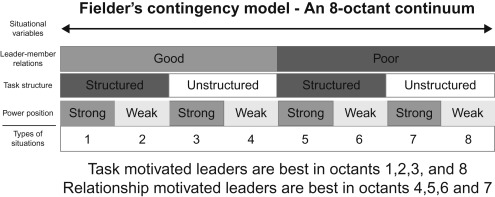Fred Fiedler Contingency Theory Model
Fred Fiedler Contingency Theory Model
Fiedler’s Contingency Theory, developed in the mid
While Fiedler’s original LSI postulated that there are two types of leader styles- authoritative and participative–Fiedler’s contingency theory can be seen as an addition to this classification system, this additional type is considered situational because it indicates how effective a leader would depend on the situation, they find themselves in.
There are numerous factors, such as “nature of the task,” “leader personality,” and make-up of group being led; all these contribute to the effectiveness or lack thereof when evaluating different leadership situations.
Fiedler’s Contingency Model focuses on understanding how group members can be involved in a project. It is based upon the assumption that different groups respond differently to different leadership styles.
Fiedler Leadership Style
Fiedler’s model postulated that there are two types of leader styles- Task-oriented leaders and Relationship oriented leaders.
Task-Oriented Leaders
- Task-Oriented Leaders focused more on getting the job done without thinking about their relationship with their subordinates.
- However, it is no surprise that a task-oriented person can run the risk of failing to deliver when they do not engage with the people around them. This goes against their natural bias, which is to finish without worrying about rapport or bond with followers. Leaders should make sure not to neglect their team members in favor of getting tasks done.
Relationship-Oriented Leaders
- Relationship-Oriented Leaders focus more on the relationship and engagement with the staff they work with. These leaders will look at the tasks once the interpersonal engagement is met.
- In a world that is becoming more and more oriented toward goal-orientation, it’s refreshing to see leaders who put their people’s emotional needs first, however sometimes to the detriment of the task and results.
How to use Least Preferred Coworker Scale Test (LPC)
You might use the Fiedler leadership model to identify your own style and how it can be used in the workplace. The LPC scale helps you measure where you fall on the spectrum of leadership styles.
You know that person who’s really good at making sure everyone is doing their work, but they’re also kind of a jerk? That’s an example of what Fiedler would call “controlling” leadership. If this is your preferred style, maybe take a look at his Least-Preferred Co-Worker Scale (LPC).
Using the model, you start by determining your natural leadership style using Fiedler’s Least Preferred Coworker (LPC).
To rate yourself on this scale, you have to describe the coworker with whom you least prefer to work.
Least-Preferred Co-Worker Scale Table
| Unfriendly | 1 2 3 4 5 6 7 8 | Friendly |
| Unpleasant | 1 2 3 4 5 6 7 8 | Pleasant |
| Rejecting | 1 2 3 4 5 6 7 8 | Accepting |
| Tense | 1 2 3 4 5 6 7 8 | Relaxed |
| Cold | 1 2 3 4 5 6 7 8 | Warm |
| Boring | 1 2 3 4 5 6 7 8 | Interesting |
| Backbiting | 1 2 3 4 5 6 7 8 | Loyal |
| Uncooperative | 1 2 3 4 5 6 7 8 | Cooperative |
| Hostile | 1 2 3 4 5 6 7 8 | Supportive |
| Guarded | 1 2 3 4 5 6 7 8 | Open |
| Insincere | 1 2 3 4 5 6 7 8 | Sincere |
| Unkind | 1 2 3 4 5 6 7 8 | Kind |
| Inconsiderate | 1 2 3 4 5 6 7 8 | Considerate |
| Untrustworthy | 1 2 3 4 5 6 7 8 | Trustworthy |
| Gloomy | 1 2 3 4 5 6 7 8 | Cheerful |
| Quarrelsome | 1 2 3 4 5 6 7 8 | Harmonious |
Source: Tables from “A Theory of Leadership Effectiveness” by Professor F.E. Fiedler. © 1967.
Fiedler argues that leaders with high LPC scores are relationship-oriented leaders, while low scores are task-oriented leaders.
According to the Fiedler model, leaders with high LPC scores get their satisfaction from interpersonal relationships with coworkers and evaluate their least preferred co-workers in fairly favorable scores. The leaders here think about the task accomplishment only after the relationship needs are well satisfied.
On the other hand, leaders with low LPC scores get satisfaction from the task’s performance and attainment of objectives. After tasks have been accomplished, the leaders work on establishing good social and interpersonal relationships.
According to Fiedler’s contingency theory, leadership style is not the only factor in a successful leader. Leaders must also maintain good relations with their followers, clearly define tasks and procedures for them, and be able to reward or punish them when necessary.
Fiedler Situational Leadership/Situational Favorability
According to Fiedler, a leader’s behavior is dependent upon the favorability of the leadership situation. Many factors can affect your work environment, such as how you relate to your team, how tasks are given, and your position’s power. A leader with strong situational control can use these factors in their favor by responding accordingly.
Three factors work together to determine how favorable a situation is to a leader: their position in both society and within the organization, the level of support they have from members of their team, and any task structures.
Position in both society and within the organization
People who are in control, like the leader of a group or organization, have power. They can use it to give rewards and punishments. The more power you have, the better your situation is going to be.
Fiedler identifies two types of power: strong and weak. Strong leaders don’t need to use their powers as often because they seem more confident and authoritative than those with weaker voices. In contrast, weak-voiced leaders must constantly use their powers for fear that someone will take over or betray them if given an opportunity.
The level of support and trust from members of the team
This also referred to the leader-Member Relations. It the level of support and trust that the team has ina leader. A leader with more support and confidence from the team is more trusted and influences within the group. This leader is the more favorable situation than a leader who is not trusted.
Did you know that people are 10% to 50% less productive when they feel their boss doesn’t have faith in them? This means if a person works 8 hours per day, they’re only getting 4-6 hours of work done! It’s important to remember this statistic so that you can show your employees how much value your company places on them by trusting them with responsibilities like these.
Task structure in the organization
Task structure means the degree to which a task has been clearly defined and is structured. For example, if it’s unclear how tasks are divided up among workers on a project or what employees should do when they arrive at work every day for their assigned job, there isn’t much task structure.
Poorly structured tasks can lead to confusion between workers on who’s responsible for what part of the process. The lack of direction in this situation may also cause employees to slack off while waiting for someone else to tell them what needs to be done.
Matching Leadership Style to the Situation
According to Fred Fiedler’s theory, effective leadership is really judged by the relationship of the leader’s personality with what they bring to the situation and the degree to which the situation allows the leader power and influence.
Successful leadership requires that you balance the situation with your unique style of leadership… If your leadership style and the situation are properly balanced, your success and the production of the community should be strong. If they are not paired, the results will be less than successful.
Task-oriented Leader in Highly favorable or highly unfavourable situation
Fred Fiedler found that the task-oriented leader works better in a favorable environment. This is because everyone on the team gets along, the mission is straightforward and organized, and the leader has enough control over the followers. In such a scenario, the team clearly needs a leader who can provide guidance.

Similarly, if the situation is extremely unfavorable, the same leadership type is perceived to be more successful than a relationship-oriented chief. This is because an adverse situation involves a leader who can provide a great deal of structure and guidance due to the task structure’s low involvement.
Moreover, because the leader-member relationship is still weak, a friendly, relationship-oriented leader would make little difference in its popularity.
Relationship-oriented leader in Moderate favorable situation

Application of Fiedler’s Contingency Theory of Leadership
In an organization that would recruit a new manager to take on a leadership position with weak current member ties, high task structure, and authority, the company will be better placed to fill this role with a high LPC or a leader-member relationship to improve poor relations.
Hiring anyone who is more emotional would assist in the restoration of the current leader-member relationships.
Fiedler Contingency Theory Advantages and Disadvantages
Fiedler Contingency Theory Advantages
- Fiedler’s Contingency Theory is highly well studied by Fiedler himself and even others who came after him. It, therefore, works in many situations and can be used specifically to decide which situations are best for the leader to lead. As such, it is a common principle and is commonly used in the field of management.
Fiedler Contingency Theory Disadvantages /Limitations and Crit
- The Fiedler Contingency Model is not very versatile at all. In Fred Fiedler’s eyes, the leadership style of the leader is based on his life experience and is therefore set for any person that cannot be changed. Instead of attempting to change the boss’s inherent tendencies, Fiedler felt it would be both simpler and more effective actually to change the manager instead.
- Some also criticize the Fiedler Contingency Model for its lack of clarity. What happens if you score near the middle of the range after the LPC scale assessment (mentioned earlier in step one)? It will be very difficult to decide precisely what kind of leader you are, making the majority of the leadership evaluation findings meaningless.


